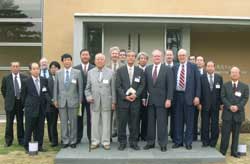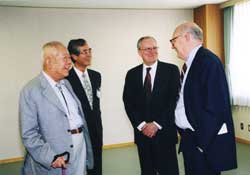
Dr. John Marburger attends K2K-II
Commencement Ceremony
Apr 24, 2003
On Saturday, April 19, 2003, the K2K-II Commencement Ceremony was held at KEK. Dr. John Marburger, Science Adviser to the President of the United States and Director of the United States Office of Science and Technology Policy (OSTP), attended. The ceremony was co-hosted by KEK and Institute for Cosmic Ray Research, the University of Tokyo. The ceremony was to commemorate the restart of the K2K experiment after the unfortunate accident of the Super-Kamiokande detector in November 2001.The detector, which has been used as the far-detector of the K2K experiment, was successfully restored during last year.
The K2K experiment, which started taking data in April 1999 and successfully collected data until July 2001, has produced results that indicate neutrino oscillations as observed previously in the atmospheric neutrinos. This finding is the first successful demonstration of a long baseline neutrino oscillation experimentation technique and the first confirmation of the Super-Kamiokande discovery of neutrino oscillation in atmospheric neutrinos using accelerator produced neutrino beam.With the improved near-detector and the rebuilt Super-Kamiokande detector, K2K-II promises to deliver more exciting results in the near future.
As Science Adviser to the President, Dr. Marburger plays a decisive role in the development of the scientific strategy of the United States. The offcial U.S. delegates to the ceremony included Dr. Norman Neureiter, Science and Technology Adviser to the Secretary of State.
The visiting schedule included a briefing onKEK programs, and a tour through the K2K neutrino beam line, the K2K near-detector, Accelerator Test Facility, and KEKB/BELLE experiment prior to the K2K-II commencement ceremony.
On April 20, as part of their visit, they also visited the University of Tokyo Kamioka Observatory in Kamioka, Japan, which hosts the Super-Kamiokande and the KamLAND experiments along with other underground experiments.
During the visit, international cooperation, especially between the U.S. and Japan, in the current and future particle physics research has been discussed, and further strengthening of the cooperation was encouraged. At lunch time, Dr. Marburger had a pleasant talk with Prof. Masatoshi Koshiba, Nobel Laureate in Physics in 2002, and said that U.S. wishes to promote a linear collider as the next generation accelerator project. This attracted much attention.
Dr. Marburger is a physicist and has been working as science administrator for many years.For example, he was the president of theState University of New York in Stony Brook and was the Director of the Brookhaven National Laboratory. This was his second visit to KEK: his first visit to KEK was in 1994.


